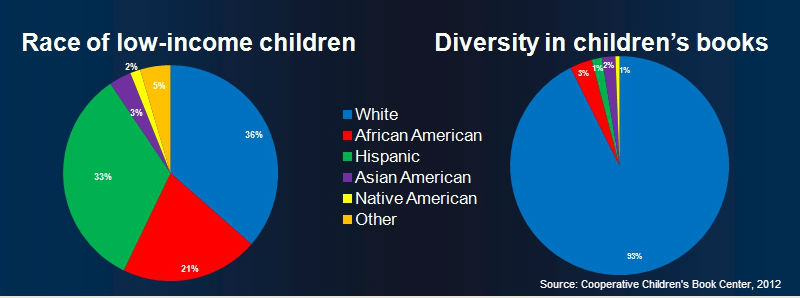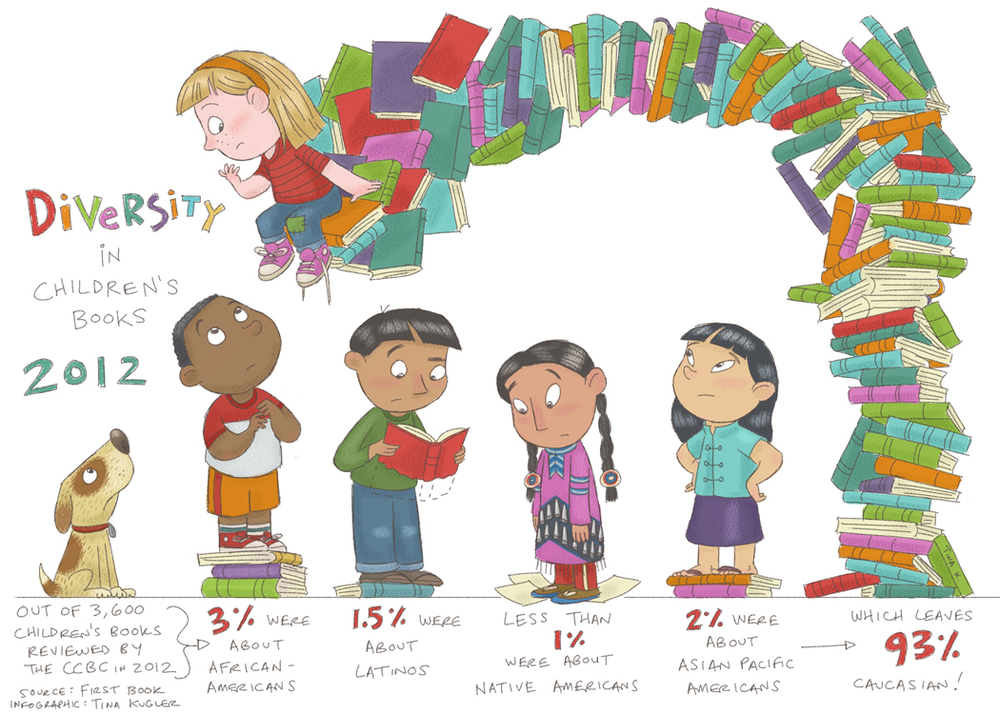In Search of Adventure: A Children’s Book Diversity Mystery
/
In 2012, 93 percent of children’s books written that year were written about white characters, according to a study by the Cooperative Children’s Book Center. There were 3,600 children’s books written that year.
Apparently the hue and cry were insufficient to change the inertia of insensitivity to the range of skin colors on American children. A similar study in 2013, recently highlighted in The New York Times, found the following: of 3,200 children’s books published last year, just 93 were about black people and 57 were about Latinos. The Cooperative Children’s Book Center is at the University of Wisconsin. 
A well-circulated illustration by Tina Kugler, spurred by the 2012 numbers, highlighted them:
- 3% were about Africans/African Americans; 1.8% were written by Africans/African Americans
- 1.5% were about Latinos; 1.6% were written by Latinos
- Less than 1% were about American Indians; less than 1% were written by American Indians
- 2% were about Asian Pacifics/Asian Pacific Americans; 2.3% were written by Asian Pacifics/Asian Pacific Americans
Back in 2008, a study by Brigham Young University found that “characters depicted in Newbery winners are more likely to be white, male and come from two-parent households than the average U.S. child,” according to published reports. The Newberry Award is the annual top honor for children’s literature.
At the time, Bloomberg News reported the following: The Chicago-based American Library Association has awarded the Newbery Medal to one book annually since 1922. All Newbery books remain in print, underscoring their enduring nature. Their popularity with teachers and parents means that for many younger children, Newbery medalists are a primary way they learn about the world and how to relate to others.
Writing in The New York Times, author and illustrator Christopher Myers pointed out last month that children “are much more outward looking. They see books less as mirrors and more as maps. They are indeed searching for their place in the world, but they are also deciding where they want to go. They create, through the stories they’re given, an atlas of their world, of their relationships to others, of their possible destinations. … Children of color remain outside the boundaries of imagination. The cartography we create with this literature is flawed.”
The National Education Association has added to its website “50 Multicultural books every child should read.” The most recent title, for children from preschool to age 12, was written in 2009.
Locally, Eastern Connecticut State University associate professor of English Dr. Raouf Mama is recipient of the 2008 National Multicultural Children's Book Award from the National Association of Multicultural Education. The author of children’s books and master storyteller, a native of Benin, Dr. Mama performs African and multicultural stories, blending storytelling with poetry, song, music, and dance. An orator out of the African oral tradition, he also lectures on African literature and African folklore and conducts workshops on storytelling and creative writing, and the power of folktales as multicultural teaching and learning tools, especially as tools for teaching literacy skills, creative writing, and public speaking.
When the American Association of School Librarians had their National Conference & Exhibition in Hartford last fall, the issue was on the agenda. One of the conference session’s dealt specifically with multicultural children’s literature. Led by acclaimed children’s book author Kelly Starling-Lyons and author Gwendolyn Hooks, the session was directed to “school librarians who want to build or expand their collections with multicultural titles.”
Conference attendees from across the country who were attending the biannual event were “invited to come celebrate a showcase of great books by African American children's book creators.” Hooks and Starling Lyons saluted titles that have been featured on The Brown Bookshelf blog.
The conference theme during those November days in Hartford: Rising to the Challenge.






























